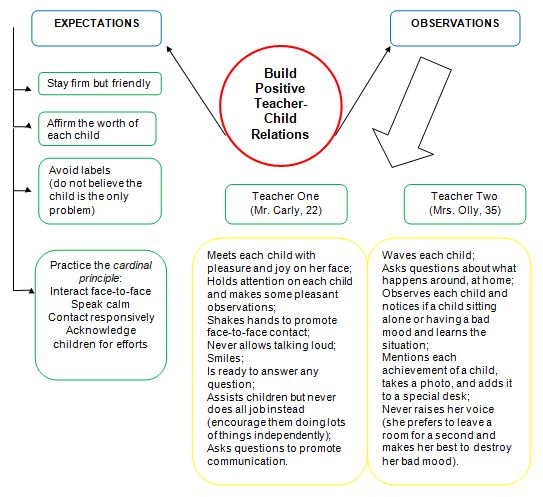Teaching Practice Choice
There are seven main teaching practices that may “define the guidance approach and set the foundation for encouraging classrooms” (Gartrell, 2013, p.118). Each has its purposes, peculiarities, and impacts on child development. The current paper aims at discussing the worth of building positive teacher-child relations. This teaching practice is based on the role a teacher performs. Early childhood teachers are the next people after parents, who start cooperating with children and playing an important role in their lives.
It is very important to create positive, successful relations and consider that this type of relations should differ from the already developed personal parent-child relations. Building positive teacher-child relations promotes the facilitation of the child’s transition between private family life and public kindergarten life. Children may face a number of challenges adjusting to public life, and positively-developed relations with teachers can make this process easier.
This is the list of teacher behaviors that are necessary to implement the chosen practice. Any teacher should:
- Accept each child as a welcome part of the group;
- Develop high-quality relations but not sincerely love every child;
- Promote face-to-face interactions with a child;
- Use a calm, pleasant voice in communication with children;
- Encourage children for efforts;
- Stay firm but friendly;
- Offer responsive contact with each child.
A Concept Map

A Birth-Pre-K Classroom Teachers’ Observations
Mr. Carly and Mrs. Olly are the two teachers, chosen for the observation in a birth-pre-K classroom. Their experience differs in 10 years; but, their approaches amaze and prove how crucial the roles of teachers are.
Mr. Carly (due to her little experience) is not always ready to find the most appropriate techniques, and her ideas are new and interesting. Mrs. Olly works longer with children, and she knows how to calm children down and occupy them within a short period of time. The results of the observations are introduced in a concept map above.
Explanations
Correlation between teacher’s classroom management practices and the selected guidance approach teaching practice
The selected teaching practice, to build positive teacher-child relation, is a good example of how teachers are able to assist little children with their first public practices. Classroom management is a combination of such issues as respect, motivation, and order (Rose, 2010). It has to be properly introduced to support children and show them how important their well-being can be.
If one of the above-mentioned aspects is missed, the success of the positive teacher-child relation is under threat. The behaviors inherent to the chosen practice (stay firm, friendly, and calm, talk to children and mind eye-contact, and acknowledge each child’s achievement) are the basic rules pre-K teachers should follow. This is why the correlation between management in the classroom and the considered practice is evident – it is difficult to organize a workshop in classrooms without properly organized (positive) teacher-child relations.
Evidence related to teaching behaviors
Observations chosen for the projects prove how important teaching behaviors can be. The difference in the professional experience of two teachers shows that the creation of positive relations between teachers and children may be organized in a variety of ways. Still, there are certain norms that have to be followed. For example, the cardinal principle that implies face-to-face contact may be in the form of waving, winking, hugging, etc.
A teacher is free to decide how to show a child that he/she notices the child’s presence; the only outcome that matters is that a child feels the teacher’s emotions about their meeting. Another example of teaching behaviors is an acknowledgment of the child’s achievements.
Teachers may use different methods to appreciate children’s activities: e.g., it is possible to create a special place with photos of children’s achievements, or encourage them orally, or give some presents (in other words, children should know that their activities are noticed and rewarded). These behaviors and examples promote building positive teacher-child relations and help children to get used to public relations.
Relationship between the guidance approach teaching practice and the NAEYC Code of Ethical Conduct
The main principles of the NAEYC Code of Ethical Conduct are to appreciate a child’s uniqueness, respect children’s dignity, and support child-family relations in all possible forms (Code of Ethical Conduct, 2005). The Code teaches to recognize trust and respect as the main factors of childhood care.
The guidance approach teaching practice chosen for the project has much in common with the Code, the only difference is that the Code presupposes trust in relations, and the practice shows that there are many ways to overcome trustful relations but make them positive for children and teachers.
It is not always necessary, to tell the truth, because little children are not always able to comprehend the truth and learn the peculiarities of trust. Still, children are always ready to recognize whether teachers have a positive mood or not. This is why the recognition of the relation between the Code and the practice helps to develop appropriate classroom management: teachers know how to behave, show their respect to children, and provide children with the necessary portion of support and understanding.
Reference List
Code of ethical conduct and statements of commitment. (2005). National Association for the Education of Young Children. Web.
Gartrell, D. (2013). A guidance approach for the encouraging classroom. Belmont, CA: Wadsworth/Cengage Learning.
Rose, E. (2010). The promise of preschool: From head start to universal pre-kindergarten. New York, NY: Oxford University Press.